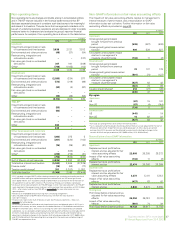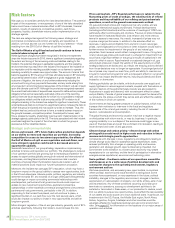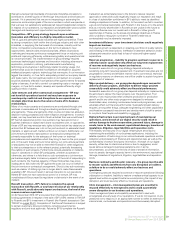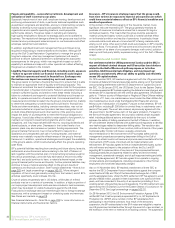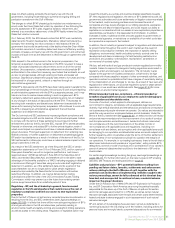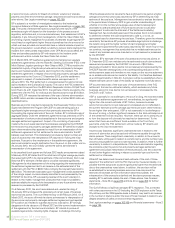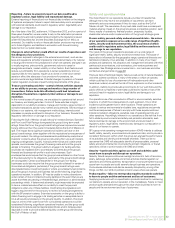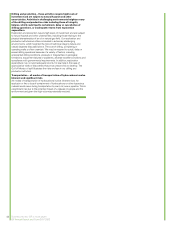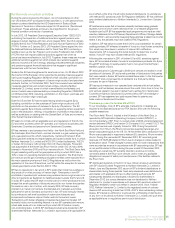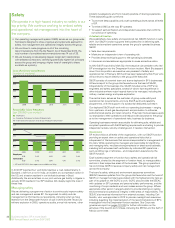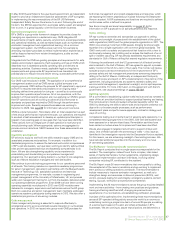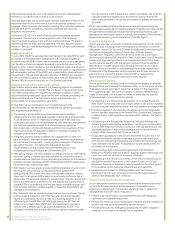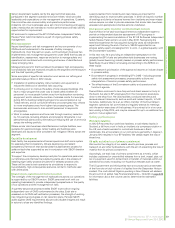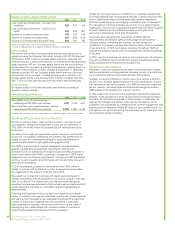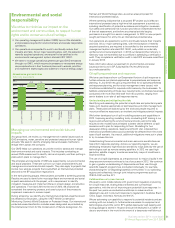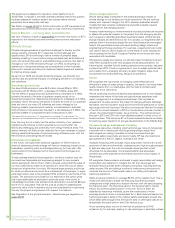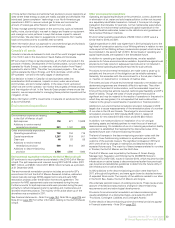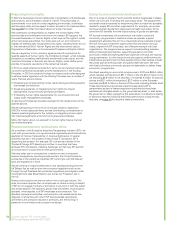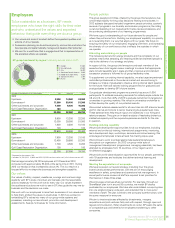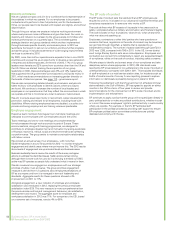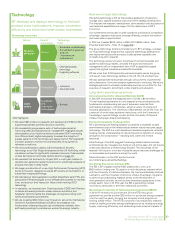BP 2012 Annual Report Download - page 49
Download and view the complete annual report
Please find page 49 of the 2012 BP annual report below. You can navigate through the pages in the report by either clicking on the pages listed below, or by using the keyword search tool below to find specific information within the annual report.
Business review: BP in more depth
Business review: BP in more depth
BP Annual Report and Form 20-F 2012
47
In May 2012 Duane Wilson’s five-year board appointment as independent
expert to provide an independent objective assessment of BP’s progress
in implementing the recommendations of the BP US Refineries
Independent Safety Review Panel came to an end. Following the end of
his term, the SEEAC appointed him as process safety expert and assigned
him to work, in a global capacity, with the Downstream business.
Operating management system
BP’s OMS is a group-wide framework designed to provide a basis for
managing our operations in a systematic way. OMS integrates BP
requirements on health, safety, security, environment, social responsibility
and operational reliability, as well as related issues such as maintenance,
contractor management and organizational learning, into a common
management system. Our OMS evolves over time, for example by
amending mandatory practices to reflect implementation experience as
well as lessons learned from incident investigations, audits and risk
assessments.
Integrated into the OMS are guiding principles and requirements for safe,
reliable and compliant operations. Each operating unit has an OMS which
describes how it addresses specific operating risks and delivers its
operating activities. Business needs, applicable legal and regulatory
requirements and group-wide BP requirements are translated into
practical plans to reduce risk and deliver strong, sustainable performance.
Conformance and continuous improvement
Our OMS was introduced in 2008. The application of a comprehensive
management system such as OMS across a global company is an
ongoing process. OMS defines the process for BP operations to apply and
conform to required standards and practices on an ongoing basis –
including defined time periods for doing so – as well as to continuously
improve their operational performance. All of our operations, with the
exception of those recently acquired, are now applying our OMS to govern
their BP operations and are working to achieve full conformance to
standards and practices required by OMS through the performance
improvement cycle. Recently acquired businesses are working to
transition to OMS. See page 99 for information about joint ventures.
OMS is a dynamic system. Periodically, after an initial assessment as part
of the annual performance improvement cycle, our operations are required
to conduct a fresh assessment to develop an updated prioritized plan in
respect of any existing gaps or new gaps that may have been identified.
These actions form an integral part of each operation’s multi-year and
annual planning cycle. Where appropriate, actions are aggregated to
provide common solutions. S&OR reviews how these assessments are
undertaken.
Capability development
BP strives to equip its staff with the skills needed to apply OMS and its
associated processes and practices. For example, in addition to a
dedicated programme to assess the technical well control competencies
of BP’s well site leaders, we have been working to identify safety-critical
roles and the associated technical and leadership competencies to do
them. We are also strengthening capability and competence by
consolidating and standardizing our competence management
programme. Our approach is being tested in a number of job categories,
such as offshore installation managers and well site leaders.
We continue to provide training programmes for our operations personnel
at all levels. This training includes our operations academy programmes
for senior management, delivered in partnership with the Massachusetts
Institute of Technology, US; specialized operational and technical
management programmes, for example, courses in engineering and
project management at the University of Manchester, UK; and process
safety and management training for our front-line leaders, delivered under
our operating essentials programme. Since 2008 we have been running
operating essentials modules and in 2012 over 6,000 modules were
delivered to managers, supervisors and technicians across the BP group.
Both non-executive and senior management team members addressed
operations academy participants during sessions in 2012. We also offer a
substantial programme of eLearning modules.
Crisis management
Crisis management planning is essential to respond effectively to
emergencies and to avoid a potentially severe disruption in our business
and operations. In 2012 we issued new group-wide OMS practices for
both crisis management and oil-spill preparedness and response, which
are replacing the interim practices put in place following the Deepwater
Horizon accident. All BP businesses and functions are required to achieve
conformance within a defined time period.
See Environmental and social responsibility on pages 51-54 for
information on BP’s approach to oil spill preparedness and response.
Safer drilling
BP has worked to centralize and standardize our approach to drilling
practices and oversight of projects with the establishment of the global
wells organization (GWO) and the global projects organization in 2011. The
GWO now employs more than 2,000 people, bringing functional wells
expertise into a single organization with common global standards. The
GWO works with our safety and operational risk function with a view to
continuously reducing risk in drilling and so reduce the likelihood of an oil
spill or incident occurring. BP has already established requirements and
standards for Gulf of Mexico drilling that exceed regulatory requirements.
Following the settlement with the US government of all federal criminal
claims related to the Gulf of Mexico, BP has agreed to appoint a process
safety monitor in the US for a term of four years. The monitor will review,
evaluate and provide recommendations for the improvement of BP’s
process safety and risk management procedures concerning deepwater
drilling in the Gulf of Mexico. Additionally, an independent third-party
auditor will review and report on BP’s implementation of key terms of the
agreement, including procedures and systems related to safety and
environmental management, operational oversight, and oil spill response
training and drills. For more information on this agreement with the US
government, see Legal proceedings on pages 162-169.
Building capability
BP is committed to establishing a global wells institute and has invested in
state-of-the art simulator facilities to support practical learning and testing.
The institute aims to build and sustain enhanced capability within the
GWO by developing the skills to deliver safe and compliant wells that will
align with our broader people processes, such as performance
development plans and performance appraisals, contractor strategy and
ways of working.
Competence testing is an important part of assuring safe operations. In a
competence testing programme in the GWO, 532 well site leaders have
been assessed on a risk-prioritized basis. Remediation activities have
been carried out where areas for improvement have been identified.
We are also engaged in targeted recruitment to support critical work
areas. One of these has been the cementing of wells – a key issue as
identified in the investigation reports into the Deepwater Horizon accident.
For this reason, we are enhancing oversight of cementing services. We
have recruited additional expertise into the company and now have
21 cementing specialists.
The Bly Report – implementing the recommendations
The Bly Report concluded that no single cause was responsible for the
accident. The investigation instead found that a complex, inter-linked
series of mechanical failures, human judgements, engineering design,
operational implementation and team interfaces, involving several
companies including BP, contributed to the accident.
The Bly Report made 26 recommendations that were specific to drilling.
We accepted all of the recommendations and are working to implement
them across our drilling operations worldwide. The recommendations
include measures to improve contractor management, as well as to
strengthen design and assurance on blowout preventers (BOPs), well
control, pressure-testing for well integrity, emergency systems, cement
testing, rig audit, verification and personnel competence.
Implementing the 26 recommendations across the group requires detailed
work and many activities – from creating new practices and guidance,
training and testing identified staff, changing requirements and
expectations of our contractors, and establishing verification processes.
A project of this scale takes time. Implementing these recommendations
across all BP-operated drilling activity across the world is an enormous
undertaking involving a programme team of around 85 people, consisting
of a central team based in Houston and others embedded in BP’s
businesses. We are working to assure that all actions are delivered to a


